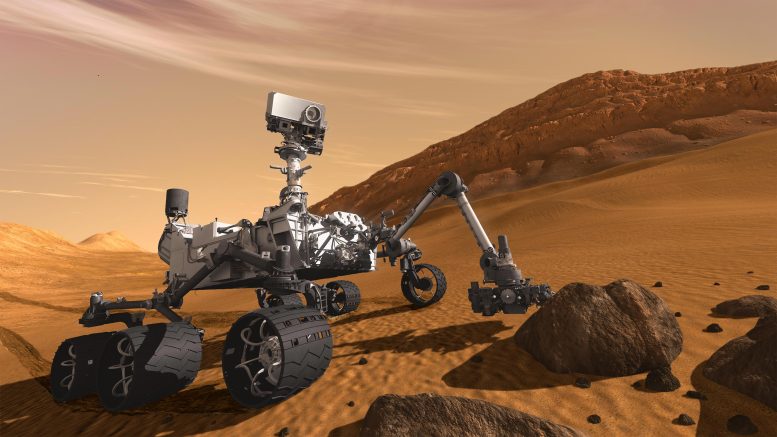
Posted on 10/09/2024 6:09:31 PM PDT by Red Badger

This is an artist’s concept of an early Mars with liquid water (blue areas) on its surface. Ancient regions on Mars bear signs of abundant water – such as features resembling valleys and deltas, and minerals that only form in the presence of liquid water. Scientists think that billions of years ago, the atmosphere of Mars was much denser and warm enough to form rivers, lakes, and perhaps even oceans of water. As the planet cooled and lost its global magnetic field, the solar wind and solar storms eroded away to space a significant amount of the planet’s atmosphere, turning Mars into the cold, arid desert we see today. Credit: NASA/MAVEN/The Lunar and Planetary Institute
=====================================================================
Curiosity’s exploration of Gale crater on Mars has uncovered new evidence about the planet’s climate evolution.
By studying isotopic values in carbon-rich minerals, scientists have discovered that ancient Mars likely underwent extreme evaporation, creating carbonates under conditions that could only support brief instances of liquid water.
Unveiling Mars’ Climate History
NASA’s Curiosity rover, currently exploring Gale crater on Mars, is uncovering fresh details about the planet’s ancient climate transition from potentially hospitable—with evidence of widespread liquid water on the surface—to the inhospitable, barren landscape we see today.
While the Martian surface is now frigid and hostile to life, NASA’s robotic explorers at Mars are investigating whether it might have supported life long ago. Using instruments aboard Curiosity, researchers measured the isotopic composition of carbon-rich minerals (carbonates) found in Gale crater, revealing new insights into the dramatic shifts in Mars’ ancient climate.

NASA's Mars Science Laboratory Curiosity Rover Artist Concept
This artist concept features NASA’s Mars Science Laboratory Curiosity rover, a mobile robot for investigating the Red Planet’ past or present ability to sustain microbial life. Credit: NASA/JPL-Caltech
Climate Shifts on Ancient Mars
“The isotope values of these carbonates point toward extreme amounts of evaporation, suggesting that these carbonates likely formed in a climate that could only support transient liquid water,” said David Burtt of NASA’s Goddard Space Flight Center in Greenbelt, Maryland, and lead author of a paper describing this research published October 7 in the Proceedings of the National Academy of Sciences. “Our samples are not consistent with an ancient environment with life (biosphere) on the surface of Mars, although this does not rule out the possibility of an underground biosphere or a surface biosphere that began and ended before these carbonates formed.”
Isotopes are versions of an element with different masses. As water evaporated, light versions of carbon and oxygen were more likely to escape into the atmosphere, while the heavy versions were left behind more often, accumulating into higher abundances and, in this case, eventually being incorporated into the carbonate rocks. Scientists are interested in carbonates because of their proven ability to act as climate records. These minerals can retain signatures of the environments in which they formed, including the temperature and acidity of the water, and the composition of the water and the atmosphere.

NASA Curiosity Mars Rover Searches Gale Crater
NASA’s Curiosity rover continues to search for signs that Mars’ Gale Crater conditions could support microbial life. Credit: NASA/JPL-Caltech/MSSS
The Mystery of Martian Carbonates
The paper proposes two formation mechanisms for carbonates found at Gale. In the first scenario, carbonates are formed through a series of wet-dry cycles within Gale crater. In the second, carbonates are formed in very salty water under cold, ice-forming (cryogenic) conditions in Gale crater.
“These formation mechanisms represent two different climate regimes that may present different habitability scenarios,” said Jennifer Stern of NASA Goddard, a co-author of the paper. “Wet-dry cycling would indicate alternation between more-habitable and less-habitable environments, while cryogenic temperatures in the mid-latitudes of Mars would indicate a less-habitable environment where most water is locked up in ice and not available for chemistry or biology, and what is there is extremely salty and unpleasant for life.”
Isotopic Evidence and Climate Implications
These climate scenarios for ancient Mars have been proposed before, based on the presence of certain minerals, global-scale modeling, and the identification of rock formations. This result is the first to add isotopic evidence from rock samples in support of the scenarios.
The heavy isotope values in the Martian carbonates are significantly higher than what’s seen on Earth for carbonate minerals and are the heaviest carbon and oxygen isotope values recorded for any Mars materials. In fact, according to the team, both the wet-dry and the cold-salty climates are required to form carbonates that are so enriched in heavy carbon and oxygen.
“The fact that these carbon and oxygen isotope values are higher than anything else measured on Earth or Mars points towards a process (or processes) being taken to an extreme,” said Burtt. “While evaporation can cause significant oxygen isotope changes on Earth, the changes measured in this study were two to three times larger. This means two things: 1) there was an extreme degree of evaporation driving these isotope values to be so heavy, and 2) these heavier values were preserved so any processes that would create lighter isotope values must have been significantly smaller in magnitude.”

Sample Analysis at Mars (SAM) Instrument
The Sample Analysis at Mars (SAM) instrument is the largest of the 10 science instruments for NASA’s Mars Science Laboratory mission, It examines samples of Martian rocks, soil, and atmosphere for information about chemicals that are important to life and other chemical indicators about past and present environments. Curiosity’s Instruments Unlock New Data Credit: NASA
Curiosity’s Instruments Unlock New Data
This discovery was made using the Sample Analysis at Mars (SAM) and Tunable Laser Spectrometer (TLS) instruments aboard the Curiosity rover. SAM heats samples up to nearly 1,652 degrees Fahrenheit (almost 900°C) and then the TLS is used to analyze the gases that are produced during that heating phase.
Reference:
“Highly enriched carbon and oxygen isotopes in carbonate-derived CO2 at Gale crater, Mars” by David G. Burtt, Jennifer C. Stern, Christopher R. Webster, Amy E. Hofmann, Heather B. Franz, Brad Sutter, Michael T. Thorpe, Edwin S. Kite, Jennifer L. Eigenbrode, Alexander A. Pavlov, Christopher H. House, Benjamin M. Tutolo, David J. Des Marais, Elizabeth B. Rampe, Amy C. McAdam and Charles A. Malespin, 7 October 2024, Proceedings of the National Academy of Sciences.
DOI: 10.1073/pnas.2321342121
Funding for this work came from NASA’s Mars Exploration Program through the Mars Science Laboratory project. Curiosity was built by NASA’s Jet Propulsion Laboratory (JPL), which is managed by Caltech in Pasadena, California. JPL leads the mission on behalf of NASA’s Science Mission Directorate in Washington. NASA Goddard built the SAM instrument, which is a miniaturized scientific laboratory that includes three different instruments for analyzing chemistry, including the TLS, plus mechanisms for handling and processing samples.
How do you have wind without atmosphere? How can dust reach escape velocity.
Anymore, I believe none of what I read, and half of what I see.
I don’t ‘recall’............
Try not to laugh when watching The Core. It is absurd.
And also, while watching it, try to keep track in your mind which way is ‘up’.................
“Our samples are not consistent with an ancient environment with life (biosphere) on the surface of Mars"
Whachu say???

Fred, donyou suppose the drastic creation of “heavy” carbonates in Gale crater was caused by the plazma strm that ddug the eep trenches across the face f Mars, as proposed by The Electric Universe theory.
It may be that those huge plasma discharges stripped Mars of its water and its atmosphere.
Mars has an atmosphere, it’s just very, very thin.
The Solar Wind strips molecules away from the outer edges of the thin atmosphere and they are lost to space.........
The process could take many millions of years.
That is a very long time to humans, but a small fraction of the existence of Mars.
One of my cranky Mars comments from 2004.
https://freerepublic.com/focus/news/1088571/posts?page=46#46
Also related to water on Mars, from 2004.
https://freerepublic.com/focus/news/1057694/posts?page=68#68
Trump can even screw the pooch on Mars climate, vote Kamala or the red planet will asplode.
Thanks Red Badger.
The rest of the martianequator keyword, sorted:
Diamonds are carbonate minerals.
Maybe it's because you don't understand enough.
After you've read a couple dozen books on Astronomy, articles like this will start to make sense to you - even though you might still choose to be skeptical about some individual claims.
Regards,
No, they're not.
A carbonate is a salt of carbonic acid, H2CO3, characterized by the presence of the carbonate ion.

Regards,
Our climate sins have gotten so shockingly bad that it now affects other planets!
Shades of Velikovsky.
—
More like a part of the Saturn Theory (Electric Universe), where the giant planet were close to the sun and the minor planets like Earth and Mars were moons of Saturn. Then there was a valence change, and now our solar system is unique, as far as we know, in having the large planets far away from the Sun.
Thus, the Martian dictatorship that was alarmed and alarming about potential heat, created a somewhat harsh, cold “climate.”
—
Later a contrary faction arose and
Death on Mars: The Discovery of a Planetary Nuclear Massacre, by plasma physicist John Brandenburg PhD
https://www.amazon.com/s?k=Death+on+mars&i=stripbooks&ref=nb_sb_noss
There are cow farts up there? Who knew...
He took a lot of derision for it too.
Disclaimer: Opinions posted on Free Republic are those of the individual posters and do not necessarily represent the opinion of Free Republic or its management. All materials posted herein are protected by copyright law and the exemption for fair use of copyrighted works.